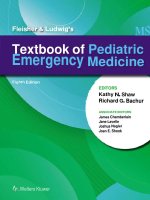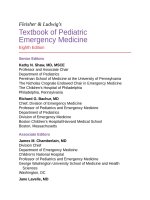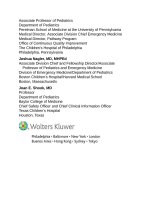Pediatric emergency medicine trisk 0320 0320
Bạn đang xem bản rút gọn của tài liệu. Xem và tải ngay bản đầy đủ của tài liệu tại đây (101.4 KB, 1 trang )
with permission, © The Children’s Hospital of Philadelphia, Philadelphia, PA; B: From
Hahnemann University Hospital, University MedEvac, Philadelphia, PA, with permission.)
PEDIATRIC TRANSPORT TEAM STRUCTURE AND
LOGISTICS
There are several common models of pediatric transport teams across the country.
Dedicated pediatric transport teams are often freestanding teams whose primary
responsibility is to transport patients. These teams do not take on direct patient
care assignments, though often assist throughout the hospital during their “downtime.” Many dedicated teams transport both neonatal as well as “pediatric”
patients, though some teams are exclusively “neonatal or pediatric.” Another
model is the “unit-based” team. These teams mobilize team members from
clinical units when a transport request is made. For example, a NICU nurse is
pulled from a patient assignment to go retrieve a patient for the NICU. Finally,
there are some programs that utilize hybrid models of the above.
Many types of providers can function effectively as part of a pediatric transport
team. Nurses, advanced practice providers (NP, PA), respiratory therapists, EMTs,
paramedics, and physicians serve on various transport teams. In general, the
personnel chosen for the transport team should have experience in the care of
critically ill infants and/or children, and be competent in the transport
environment. Excellent bedside clinicians may be less effective in the transport
environment if they do not know where to find resources in the ambulance or
helicopter, how to turn on the oxygen or suction. Additionally, motion sickness
impairs the clinician’s ability to optimally care for the patient. The team may not
be ideal if one of the providers is limited in ability to perform specific patient care
tasks, such as medication administration and delivery. Finally, while the transport
environment is a tremendous place to learn patient care in austere settings, space
constraints often limit the addition of additional learners.
The primary mission of the team must be kept in mind when selecting
personnel and planning training. For example, a team devoted to neonatal
transport should consider team members with experience in the care of critically
ill neonates, whereas teams that also perform transports from nonhospital
locations may want to employ personnel with prehospital care experience. Teams
that have more broad-based missions, such as those that transport both neonates
and older children, should attempt to recruit team members from varied hospital
areas, including the NICU, PICU, CICU, and emergency department. **By
necessity, such teams have to devote considerable time to the medical crosstraining of staff members. However, having team members from varied









